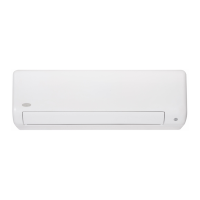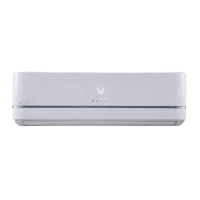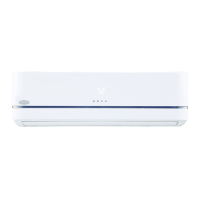
Do you have a question about the Carrier 40MAHB Series and is the answer not in the manual?
| Brand | Carrier |
|---|---|
| Model | 40MAHB Series |
| Category | Air Conditioner |
| Language | English |
Warning about electrical shock during installation/servicing.
Warning about explosion risk with oxygen/air mixtures.
Caution about potential equipment damage from improper practices.
Guide for connecting power and communication wires.
Information on insulating refrigerant lines.
Procedure for achieving a deep vacuum for system evacuation.
Alternative method for system evacuation using dry nitrogen.
Inspection of refrigerant tubing after installation.
Protections related to indoor fan speed control.
Protection functions of the inverter module.
Issues with indoor fan startup delay and zero crossing detection.
Protection for sensor open circuits or disconnections.
Details of the FAN mode operation.
Rules governing indoor fan speed in cooling mode.
Protection mechanism based on evaporator temperature.
Rules for indoor fan speed in heating mode.
Auto fan behavior during heating operations.
Description of the defrosting mode.
Details of the drying mode, including protection.
Protection against low evaporator coil temperatures.
How the auto mode selects between cooling, heating, or fan only.
Controls for forcing specific operation modes.
Automatic restart feature after power interruption.
System for detecting refrigerant leaks.
Feature to memorize the louver's last position.
Specifics of heating operation at 8°C.
Mode for reduced noise operation.
How to enter and navigate the inquiry mode.
Caution about residual electricity in capacitors.
Diagnostic table for unit sizes 9K-18K.
Diagnostic table for unit sizes 24K-36K.
Outdoor PCB EEPROM or compressor chip feedback error.
Indoor unit cannot communicate with the outdoor unit.
How to test DC voltage between outdoor unit ports.
How to test reactor resistance.
PCB not receiving zero crossing signal feedback.
Indoor fan speed too slow or too fast.
Outdoor fan speed too low or too high.
How to test the outdoor DC fan motor.
Indoor temperature sensor open circuit or short circuit.
Outdoor temperature sensor open circuit or short circuit.
Detection of refrigerant leakage.
Indoor PCB does not receive feedback from display board.
Abnormal current rise detection.
IPM sends abnormal voltage to compressor drive chip.
Abnormal voltage increase or decrease.
IPM module temp/pressure protection.
Outdoor pressure switch shuts unit down due to low pressure.
Abnormal inverter compressor drive detected.
Rules for conflicts in multi-unit systems.
Resistance values for temperature sensors T1-T4.
Resistance values for temperature sensor T5.
Formula for converting Fahrenheit to Celsius.
Procedure for checking IPM continuity.
Steps to remove the front panel.
Steps to remove the panel frame assembly.
Steps to remove bottom panel and support bar.
Steps to remove the display board.
Steps to open and secure the electrical control box cover.
Steps to disconnect wires and remove the main control board.
Steps to remove the electrical control box assembly.
Steps to remove the evaporator assembly.
Steps to remove screws securing the evaporator.
Steps to remove the fan motor and fan assembly.
Steps to remove bearing sleeve and fan assembly.












